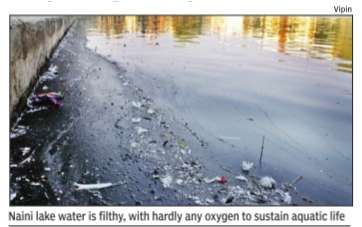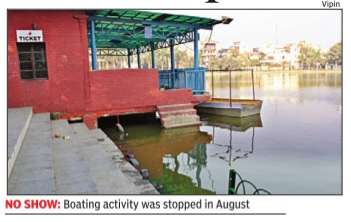Delhi: N
This is a collection of articles archived for the excellence of their content. |
Contents |
Naini Lake
(Model Town)
Paras Singh, AAP-BJP tussle kills revival plan of dying city lake, Dec 29 2016 : The Times of India
A plan to revive the dying Naini lake in Model Town was prepared in 2015 by a top biologist but it hasn't been implemented as control of the lake changed hands from the city government to the municipal body.
On August 3 this year, the BJP-controlled north corporation decided not to renew the Delhi tourism department's lease to manage the la ke. This was after a sustained citizens' campaign had forced the department, which comes under Delhi government, and north corporation to sign an MoU to revive the lake. The civic body junked the agreement, deciding in stead to “redevelop“ the lake on its own despite being cash strapped. Five months have elapsed, but Naini's water is still greenish and turbid, devoid of life. Its regenration will provide a blueprint for revival of other waterbodies, say environmentalists.
Corporation functionaries were found to be clueless about the ecological revival of the lake and focused instead on restarting recreational activities such as boating.
The turbid, green water, experts say, indicates algal bloom and low dissolved oxygen.Meanwhile, the civic body continues to pump groundwater from borewells into the lake.
Biologist C R Babu from the Centre for Environmental Management of Degraded Ecosystems, who had drawn out a plan to ecologically revive the lake last year, explained why the move would further damage the lake. “ A living water body has a natural inlet and an outlet. But here groundwater through borewells is being used to recharge water. And since the water table in the area is less than 30 feet, the water being pumped up may be highly saline and destroy the lake instead of reviving it,“ Babu said.
When the corporation decided to go solo, the tourism department had stopped boating activity from August 10 2016. Along with that, the canteen and the musical fountain were also shut. The corporation had roped a private company but it left within a month. “Plans would be tentatively completed by April-May . We are making a policy about outsourcing it to a company which has expertise to operate the lake,“ said V P Pandey , the leader of house in north corporation.
Najafgarh
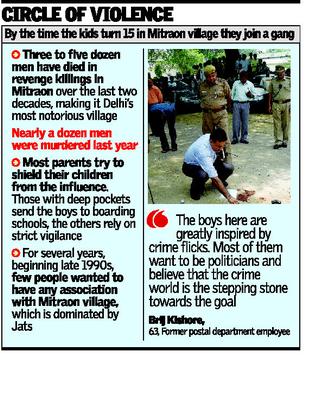
The Hindu, January 25, 2016
Shiv Sunny
Gangsters are legends in this village
Elders of the notorious Mitraon village in Najafgarh rue the loss of a generation to violence.
If anyone ever suggests ‘Fauzi’ or ‘Balraj’ during the naming ceremony of a child in this village, they draw scornful and warning stares. But these are the very names many children demand to be rechristened with when they breach their teens.
Welcome to Mitraon village in Najafgarh area in South West Delhi whose younger generation idolises gangsters like Fauzi and Balraj — they are nothing less than “legends” for the teenagers here.
As per various estimates, three to five dozen men have died in revenge killings in Mitraon over the last two decades, making it arguably Delhi’s most notorious village. Since the start of last year, when four villagers were found charred in a car, around a dozen men have already been murdered.
It all began over a few acres of land in the 1990s. Today, this village has produced some of the most notorious gangsters like Manjeet Mahal, Naveen Khati and Ravinder Bholu.
“Today, the rivalries are no more just over property or money. It is now over a false sense of honour,” says Dependra Pathak, Joint Commissioner of Police (South-Western Range).
The younger lot in this village are inspired by Indian films that show orphans rising from railway tracks to rule over the underworld. They want to imitate gangsters who arrive at the village in suave SUVs with bodyguards flanking them.
Most parents do all they can to shield their children from the influence. Those with deep pockets send the boys away to boarding schools outside Delhi at the first opportunity.
The less fortunate ones rely on strict vigilance. They allow their children to interact with very few friends and track their movements closely.
“There are times when I have paid surprise visits to his school and even secretly followed him by another vehicle to know which places he visits and whom he interacts with,” says Sandeep Gehlot, father to a 16-year-old boy.
For several years Mr. Gehlot kept the TV remote with him. “I allowed my son to watch only children’s shows like Chhota Bheem and Motu-Patlu. He was never allowed to watch gangster films,” says Mr Gehlot, a farmer.
Sandeep is not alone when it comes to monitoring what children watch on TV. “The boys here are greatly inspired by crime flicks. Most of them want to be politicians at a later stage in life and believe that the crime world is the stepping stone towards the goal,” says Brij Kishore, a 63-year-old ex-employee with the postal department.
By the time the children turn 15, they are associated with one of the several small gangs from the village. Once the gang leader is arrested or killed, they see an opportunity to break away and form their own gang.
Even after severe crackdown on the gangs in the past, there are 15-20 small and big gangs operating from the village. A murder here is followed by another and the revenge cycle goes on.
All this takes its toll on the youth, particularly girls, when they reach marriageable age. For several years, beginning late 1990s, few people wanted to have any association with Mitraon village, which is dominated by Jats.
“Many members of our younger generation were unable to find brides or grooms because of fears of early widowhood or getting into legal troubles. The only thing residents of other villages discussed about Mitraon were the gang-wars. It became embarrassing for us to visit another village,” says Om Krishan, a local.
Despite no dip in the crime scene, the marriage situation has improved claim villagers. Yet, it took a retired government teacher of the village two years before he could find a groom for his daughter who was by then “way past her marriageable age”.
“My daughter is a government school teacher and under normal conditions she would have found enough suitors,” says the teacher, insisting that he faced this hurdle despite no one from his family being ever associated with any gang.
The older generation claims to have done their bit to end the rivalries between residents of the around 12,000-strong village. Village elders say they attend weddings at each others’ homes even as their sons and grandsons are warring against one another. But this has had little impact as the young criminal elements show scant regards for their elders. “Even at this age I am scared to smoke in front of my father. But the younger members do not care to even hide their guns when they come home,” says the school teacher.
Amid all this, police have been holding regular meetings with the village heads to keep the youngsters in check, but the ground reality is that they know that a round-the-clock deployment of a good number of police personnel in and around this village is the only way to prevent violence here.
Naraina
Loha Mandi, 2016
The Times of India, Sep 03 2016

Paras Singh
Four decades after its shift from Motia Khan, the iron market at Naraina is still grappling with infra problems. It all started on a very promising note, though
The shifting of Loha Mandi (iron market) from Motia Khan to Naraina in 1975 shows that the authorities have to be firm with wholesale merchants when relocating them, yet simultaneously take care to provide them better amenities than they are currently used to. Undertaken though forceful means rather than collective persuasion, the Naraina shift was swift and smooth.
“Those were the days of the Emergency and the might of the state was behind Sanjay Gandhi, whose right-hand man Jagmohan had conceived of the project,“ recalls one of the oldest iron traders at Naraina.
“They placed the bulldozer in front of our shops and asked us to move to the current site which then used to be a jungle.“
Almost all of Motia Khan's 750 traders were shifted to the outskirts at one go. Agarwal remembers that most were reluctant to move, but were promised better facilities in Naraina. “We operated in tents in the initial days,“ the elder merchant adds. Today, the loha mandi is a hub for more than a thousand traders. Setting up shop in Naraina successfully diverted unwanted traffic from an already crowded Sadar Paharganj.
It is not all paradise, however.Traders complain that the basic infrastructure has deteriorated. “The roads are damaged, there is no provision for parking of trucks or efficient drainage and sewage system,“ points out Vilayati Ram, who heads the Iron Merchants' Welfare Association and is among the few remaining iron traders who also operated from Motia Khan.
Neb Sarai
Murals and art
The Times of India, Sep 29 2015
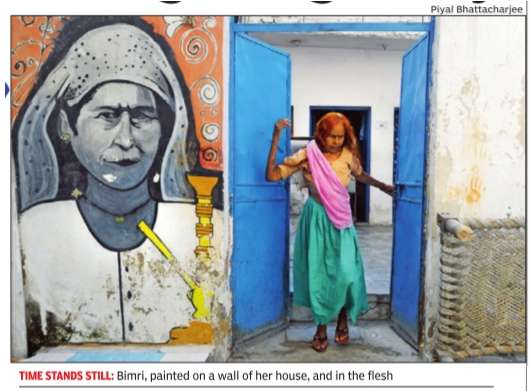

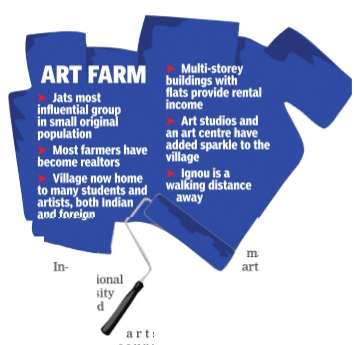
Risha Chitlangia & Richi Verma In Neb Sarai, each wall is a canvas and every street a living art gallery
The pursuit of art and “struggle“ go hand in hand, but for broke artists living on a dream to make it big, Neb Sarai village in south Delhi offers an affordable roof and unlimited canvas space. Most streets in the village have a wall or two painted over with a portrait or abstract art--the work of resident artists. While the villagers don't understand all of the ideas behind the murals, they are appreciative enough to let their own children assist and learn from tomorrow's masters. Without the artists, Neb Sarai is mere haphazard growth--unauthorized and lacking basic amenities for its mushrooming population. But in its middle lies NIV Art Centre that has become a platform for struggling and upcoming artists to sharpen their skills and reach a wider audience. Painters, sculptors, street artists, caricaturists and designers from across the country make it a base in their early careers.
Although NIV opened in 2007, it became popular only after Indira Gandhi National Open University (Ignou) started a masters programme in fine arts.“The full-time course attracted a lot of budding artists, most of whom lived in this village,“ said Avtar Singh, a painter from Punjab who was in the first batch.
Shailesh, a sculptor from Uttar Pradesh, chose to live there because “If you want to make it in the art world, you need to live close to the community .“ He needs to use strongly smelling chemicals that few landlords would tolerate but in Neb Sarai he found space for a studio quite cheaply . He has lived in the village for three years and says, “The locals are cooperative and accommodating. R Ritesh, an art historian who works with Niv Art Centre, said even foreign artists live in the village. “Every year, around 300 art ists come and go at the centre.“
Some artists leave in weeks, others stay on for years. “The vil lage is a perfect loca tion as we are close to the mainstream market, and yet affordable, said Singh. Room rents vary from Rs 5,000 to Rs, 12,000 depending on the space and privacy they offer. Bimri's portrait greets passersby from the outer wall of her house. She let a young artist paint it and says, “It is nice to have these people in the village. They have painted the walls with beautiful colours.“
The 70-year-old has seen Neb Sarai transform from a cluster of “huts and very few pucca houses“ in the days when most of its residents worked as labourers.“This is no longer a village but just like any other colony,“ she added.
Two lanes ahead, Phoolwati proudly shows a mural of monkeys painted on an outer wall of her house. Her 10-year-old son had helped the artist and got to learn from him in return. “He has painted some murals inside the house as well,“ she said.
Neela Hauz Biodiversity Park
Neela Hauz lake is regenerated
Jasjeev Gandhiok, Lake's blues end with green push, Nov 15 2016 : The Times of India
Once A Dumping Ground, Neela Hauz Now A Symbol Of Environmental Regeneration
The Neela Hauz lake, a natural depression near Sanjay Van in south Delhi, once the source of drinking water for the locality , had turned into a dumping ground for malba and raw sewage from the surroundings. After its revival through entirely natural means, the lake is now the symbol of environmental regeneration at the Neela Hauz Biodiversity Park, Delhi Development Authority's latest addition to such green belts in the capital.
When local residents approached Delhi high court about the dismal condition of Neela Hauz, the area was handed over to DDA under its Delhi Biodiversity Foundation, and scientists and engineers started the revival process immediately . Within two years, the lake had been desilted to enable landscaping of the biodiversity park. Alongside, a wetland was constructed, which now treats close to a million litres of water every day through natural processes.
“No energy is being consumed for the process,“ said CR Babu, professor emeritus, Delhi University , and head of the Centre for Environmental Management of Degraded Ecosystems. “We are only using tanks and aquatic plants with special properties to clean the water.“
According to Babu, the process to design the constructed wetland took around two years. Just before the water enters the lake, it flows past a series of alternating troughs and gravel beds with aquatic plants growing on them. The professor explained that microbes generated by the 20 different types of aquatic plants cleansed the water of biotoxins, while sludge and fine particulates were removed via a gradual process of passing the water through layers of pebbles of varying sizes. “No sewage treatment plant in Delhi has proved this efficient in improving water quality , and we have achieved this through an all-natural process,“ said Babu.
When the scientists discovered that the water flowing into the lake was extremely high in phosphates and nitrates, an aquatic species called lemna was introduced. They not only naturally absorbed these compounds, but, as Yasser Arafat, who worked on the water body purification, narrated, “We used these nitrate and phosphate-rich lemna as fertilisers after collecting them from the water.“ The lake's biological oxygen demand (BOD) levels, along with the level of phosphates and nitrates, fell sharply. According to Faiyaz Khud sar, scientist in charge at DDA 's Yamuna Biodiversity Park, the revived water body at Neela Hauz is already attracting avian and aquatic species. “A dual purpose is being served through the constructed wetland system,“ said Khudsar. “The biodiversity park is producing plants that can be used as fertiliser, and at the same we are seeing the arrival of ducks there.“ Since its revival, 70 bird species have been sighted at Neela Hauz.
The regeneration model has proved so successful that officials have submitted the concept to Delhi Jal Board for implementation in other water bodies across Delhi. “We have shown the plan to the DJB. The water supply agency felt this system could be used in over 69 water bodies without the costs being very high because no additional energy would be consumed,“ said Babu.
Nehru Place
2016: Hawkers’ prices driving shopkeepers out
The Times of India, May 12 2016
Risha Chitlangia
Civic Upgrade, Squatter Eviction Stalled In Blame Game Between DDA, Traders
Nehru Place was planned as a space for work, shopping and recreational activity. For long, however, the market was purely a commercial hub for computers and accessories. Of late, with new restaurants opening, the district centre is finally assuming the contours of the originally conceived multifunctional public space. That is the good news. The bad news is that nobody among the current business owners at Nehru Place thinks the market is ready for its new avatar. Nehru Place was developed by the Delhi Development Authority in the late 1970s, and its age is showing: broken pavements, wires dangling dangerously above the avenues, inadequate toilet facilities, poor illumination after sunset and massive encroachment by hawkers.The existing amenities simply cannot meet the needs of the three lakh people who visit the place every day . With the Janakpuri-Botanical Garden Metro line opening soon, the burden on Nehru Place could become unsurmountable. Amid this chaos, a blame game goes on. The traders' association says that all requests for basic civic services and a check on encroachment have fallen on deaf ears. DDA officials counter, “Shop owners and building owners are responsible for the maintenance of the individual buildings.“ DDA transferred the maintenance of the district centre to the South Delhi Municipal Corporation in 2014, though the civic body is responsible only for upkeep of the common areas. DDA offi cials say that the original allottees were supposed to form an association to undertake repairs and maintain the market, financed partly by a portion of the ground rent collected by DDA. But the association was never formed.
“Dustbins are overflowing with waste, trash is piling up in the corridors, and the toilets are extremely dirty ,“ complained JK Gupta, chairman of the Nehru Place Welfare Association. “There are just four-five public toilets here.“ For their part, South Corporation officials said 20 sanitation workers are deployed daily at the market. Almost every available space in the piazza has been taken over by hawkers selling everything from cellphone covers to books and shoes. “The illegal vendors return within days of their removal by corporation officials,“ resented Rajinder Gupta, vice-president of the traders' association.
Not surprisingly , this has affected business. “We have lost more than 50% business to these hawkers,“ said Naushad, who runs a mobiles accessories store. “They sell inferior quality goods but at much lower prices. Why would people come to our stores?“ He is contemplating shutting shop because business returns are not commensurate with the rent he pays.
The market was declared a no-hawking zone in 2000, but the decision was challenged in the Delhi high court by some vendors. While transferring the market, DDA gave South Corporation a list of 114 vendors authorised by the court to hawk their wares at Nehru Place.“We can't remove them, but we routinely swoop down on illegal hawkers,“ claimed Mona Sreenivas, deputy commissioner (central zone), South Corporation. “It is Delhi Police's responsibility to keep a check on unauthorised vendors.“
There is still hope for the market because urban planners feel a rejuvenated Nehru Place could make public spaces accessible to the people living in colonies in the vicinity of the market. Arunava Dasgupta, head of urban design at School of Planning and Architecture, which has carried out two studies for internal use, said, “There is a possibility of greater engagement with the public by providing community-oriented services. With slight design changes, the whole area, the market included, can be revived as a social-cultural hub. The district park nearby could be used for art and cultural activities too.“ Nehru Place awaits that reincarnation.
Nizamuddin basti
Atgah Khan's tomb
Illegal encroachment
Sources:
The Times of India, August 11, 2015
The Times of India, October 3, 2015
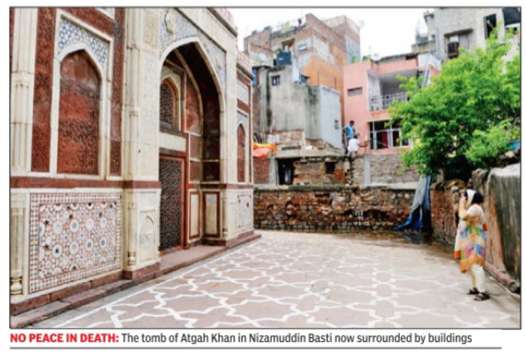
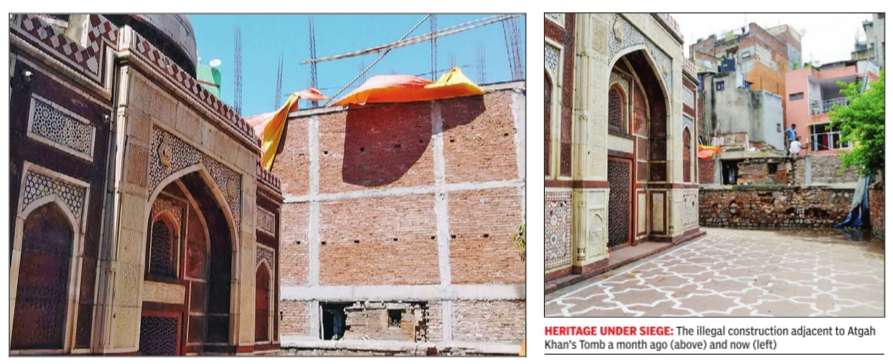
The tomb is situated on the northern edge of Nizamuddin, known for the dargah of the 13th century Sufi saint Nizamuddin Auliya.An inscription on the southern door of the tomb mentions that it was finished in the mid-16th century.
Historians said there were graves in the area around the tomb, where the unauthorized construction was taking place. “Atgah Khan's tomb has a crypt that is much larger than the domed tomb structure. The house is actually being built on the top of the crypt, said a source. The crypt of the tomb has been illegally occupied for many years and the ASI has not been able to get it vacated. The ASI has not found it easy to keep tabs on illegal construction and encroachments around the tomb. The area of Nizamuddin is very densely populated with a number of encroachments near the monument over the past few years.
ASI says monument under threat as Delhi Police And South Corporation ignored its multiple complaints
In 2015, Archaeological Survey of India (ASI) filed a police complaint against an unauthorized construction adjacent to the 16thcentury tomb of Mughal noble Atgah Khan in Nizamuddinbasti. With no action by the authorities, the construction has now materialized into a three-storey building. According to officials, the construction work was first spotted by locals. Locals from the area said that overnight a new building suddenly came up right on top of the wall surrounding the tomb. The illegal building now overshadows the tomb. Historians said that there were graves in the area around the tomb, where the unauthorized building was coming up. “The tomb has a crypt that is much larger than the domed tomb structure. The building is actually being built on the top of the crypt, said a source.
The area is very densely populated, and a number of encroachments have taken place near this monument over the last few years. The crypt of the tomb has been illegally occupied for many years, and Archaeological Survey of India has not been able to get it vacated.
Abdur Rahim Khan-i-Khanan’s tomb
The Times of India, Jun 23 2016
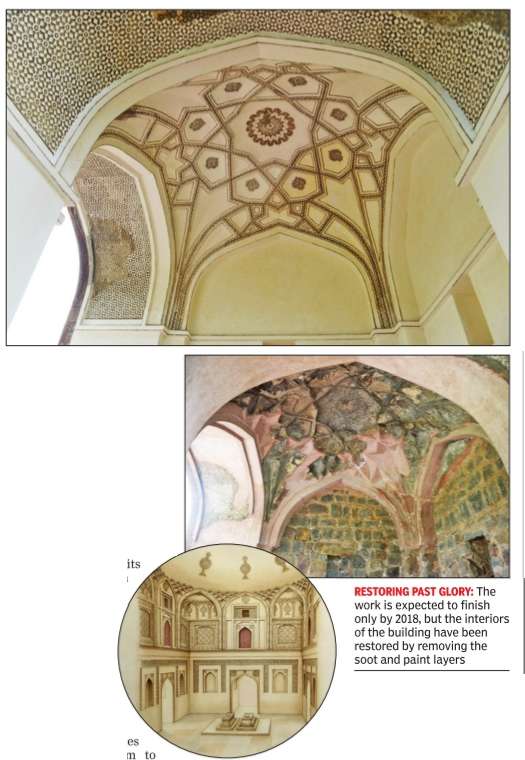
Richi Verma
Walkways to bring Humayun's Tomb closer to Rahim Khan's
Conservation of the tomb has been on, and officials say it would be linked to the world heritage site through walkways. After that, Unesco would be requested to extend the buffer zone of Humayun's Tomb to include this tomb as well. This zone already includes the Nila Gumbad, Mughal tombs in Sunder Nursery, and Bada Batashewala and Chhote Batashewala mahals.
Rahim Khan's tomb, an ASI protected monument, is being conserved by Aga Khan Trust for Culture in association with Interglobe Foundation. The work is expected to finish only by 2018, but the interiors of the building have been restored by removing the soot and paint layers. The original incised plasterwork has survived, stunning the heritage experts.
The work started in late 2015 after a year of paperwork and research culminating in a detailed conservation plan. AKTC officials said it was a mammoth effort to ensure that the tomb was firmed up with multi-disciplinary expertise and skills of master craftsmen.
“One of the first jobs undertaken at Rahim's tomb was to carefully stitch the deep and threatening cracks in the walls supporting the dome cracks that would have led to certain collapse of portions of the building if left unattended,“ said an AKTC official.
It's said that the dome was stripped off its marble for use on Safdarjung's Tomb.“It was thought that the missing sandstone from the walls and the flooring had been similarly moved to Safdarjung's Tomb. But a study of archival images as well as a comparison of stones led the project team to conclude that much of the sandstone missing from the facade was lost gradually from the late 19th century onwards,“ said an official.
There were major repairs in 1923-26 in which quartzite was used instead of sandstone. These 20th-century repairs would be retained, but even these need repairs. “In some cases, no evidence of original material was visible. So we don't know if sandstone or marble was used, and if it was plain or decorative. In such cases, the conservation effort would have to be lim ited to ensuring long-term stability as conservation norms require all decisions to be based on evidence of the original builder's intention,“ said an official.
Historians say Abdul Rahim was a general and a poet during Akbar's time, who not just wrote dohas but also translated the Ramayana into Persian and was close to Tulsidas.These aspects of Rahim's life would be presented at a festival next year.
